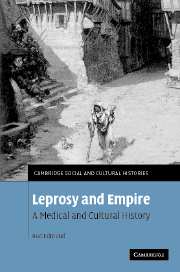Book contents
- Frontmatter
- Contents
- List of illustrations
- Acknowledgements
- Introduction
- 1 Describing, imagining and defining leprosy, 1770–1867
- 2 Scientists discuss the causes of leprosy, and the disease becomes a public issue in Britain and its empire, 1867–1898
- 3 The fear of degeneration: leprosy in the tropics and the metropolis at the fin de siècle
- 4 Segregation in the high imperial era: island leper colonies on Hawaii, at the Cape, in Australia and New Zealand
- 5 Concentrating and isolating racialised others, the diseased and the deviant: the idea of the colony in the later nineteenth and early twentieth centuries
- 6 Writers visiting leper colonies: Charles Warren Stoddard, Robert Louis Stevenson, Jack London, Graham Greene and Paul Theroux
- Postscript
- Index
6 - Writers visiting leper colonies: Charles Warren Stoddard, Robert Louis Stevenson, Jack London, Graham Greene and Paul Theroux
Published online by Cambridge University Press: 17 July 2009
- Frontmatter
- Contents
- List of illustrations
- Acknowledgements
- Introduction
- 1 Describing, imagining and defining leprosy, 1770–1867
- 2 Scientists discuss the causes of leprosy, and the disease becomes a public issue in Britain and its empire, 1867–1898
- 3 The fear of degeneration: leprosy in the tropics and the metropolis at the fin de siècle
- 4 Segregation in the high imperial era: island leper colonies on Hawaii, at the Cape, in Australia and New Zealand
- 5 Concentrating and isolating racialised others, the diseased and the deviant: the idea of the colony in the later nineteenth and early twentieth centuries
- 6 Writers visiting leper colonies: Charles Warren Stoddard, Robert Louis Stevenson, Jack London, Graham Greene and Paul Theroux
- Postscript
- Index
Summary
Crossing the boundary
Leper colonies attracted visitors. As the spread of European empires improved communications and made ocean voyaging easier, a new kind of traveller-writer was drawn to the more remote and hazardous outposts of the imperial world. Damien's colony on Molokai became part of the itinerary for those embarking on Pacific voyages from the eastern seaboard of the United States: Charles Warren Stoddard, Robert Louis Stevenson, Jack London and Charmian Kittredge all visited and wrote about the experience. The pull of the leper colony continued well into the twentieth century. Graham Greene became its most famous cicerone, and Paul Theroux provides a further example later in the century. These writers will be the focus of my concluding chapter.
The draw of the leper colony was another consequence of the revived fear of leprosy and the more rigorous confinement of its victims in the later nineteenth century. Unlike those who wished to be protected from the sight and danger of the leper, these traveller-writers – most of them critical of imperial power – were tempted to transgress the boundaries placed around the leper and enter the camp. They had different individual reasons for making this journey but as each of them passed over to the other side they inevitably became entangled in the complex Judeo-Christian tradition of abjuring and cherishing the leper.
There were financial rewards for penetrating the camps, colonies and dark places of the earth.
- Type
- Chapter
- Information
- Leprosy and EmpireA Medical and Cultural History, pp. 220 - 244Publisher: Cambridge University PressPrint publication year: 2006



